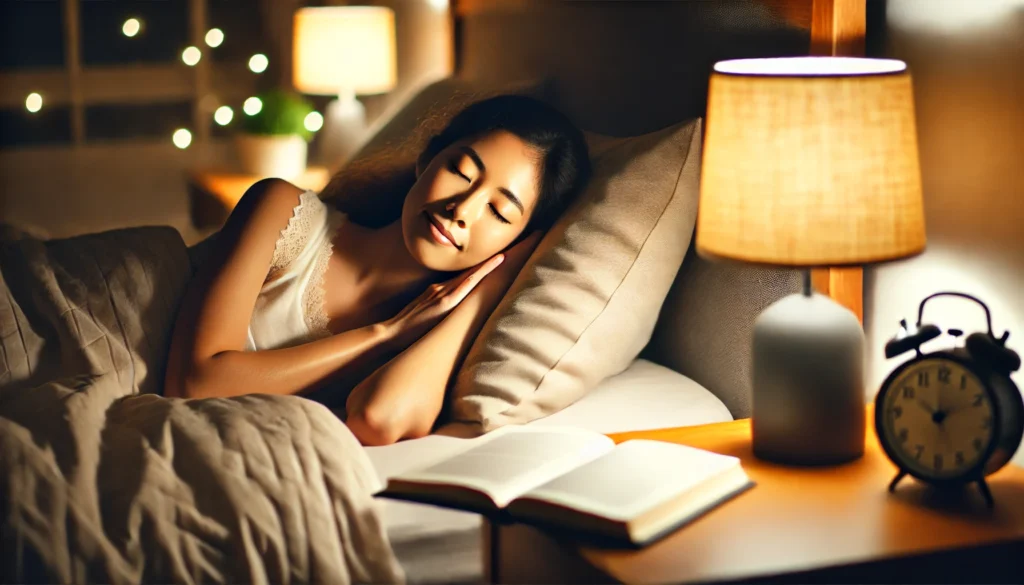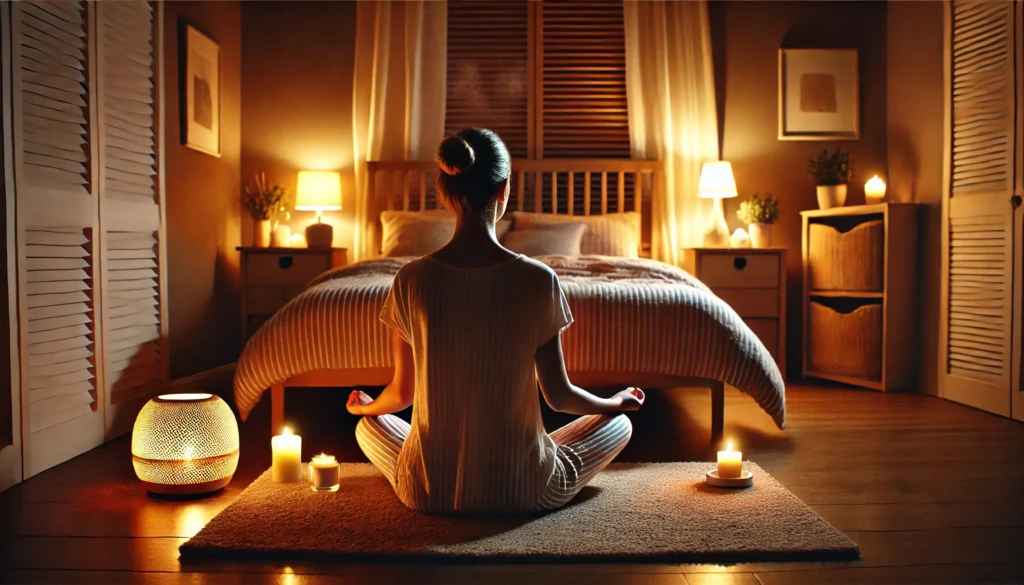In our fast-paced, always-connected world, achieving a restful night’s sleep can feel elusive. Many struggle to unwind after a busy day, leading to restless nights and groggy mornings. However, integrating relaxation techniques into your nightly routine can significantly improve sleep quality. These strategies not only help in calming the mind but also prepare the body for a rejuvenating slumber. This article delves into various relaxation methods that can aid in promoting better sleep, offering both scientific insights and practical applications.
You may also like: Top 10 Herbs for Stress Relief
The Science Behind Relaxation and Sleep
Understanding the physiological connection between relaxation and sleep is crucial. Sleep is a state where the body undergoes repair and rejuvenation, facilitated by the nervous system. The autonomic nervous system, comprising the sympathetic (fight or flight) and parasympathetic (rest and digest) systems, plays a pivotal role here. Relaxation techniques primarily aim to activate the parasympathetic nervous system, which lowers heart rate, reduces blood pressure, and induces a state of calm, setting the stage for sleep.
How the Autonomic Nervous System Affects Sleep
The autonomic nervous system is divided into two main components: the sympathetic and parasympathetic systems. The sympathetic system is responsible for our body’s “fight or flight” response, which can keep us alert and awake. In contrast, the parasympathetic system promotes “rest and digest” functions, necessary for relaxation and sleep. By engaging the parasympathetic system through relaxation techniques, we can transition our bodies from a state of alertness to one of calmness, making it easier to fall asleep.
Hormonal Influences on Sleep
Hormones play a vital role in regulating sleep cycles. Melatonin, often referred to as the sleep hormone, is produced by the pineal gland in response to darkness and helps regulate sleep-wake cycles. Cortisol, another hormone, is known for its role in stress response and can disrupt sleep when levels are elevated. Relaxation techniques can help balance these hormones, reducing cortisol levels and promoting melatonin production, thereby enhancing sleep quality.
Neurochemical Changes Induced by Relaxation
Engaging in relaxation techniques can lead to neurochemical changes in the brain that promote sleep. Activities like deep breathing and meditation increase the production of neurotransmitters such as serotonin and gamma-aminobutyric acid (GABA), which have calming effects on the brain. These neurochemicals help reduce stress and anxiety, setting the stage for a restful night’s sleep.
Progressive Muscle Relaxation for Sleep
Progressive Muscle Relaxation (PMR) is a time-tested technique that involves tensing and then slowly releasing different muscle groups in the body. This method not only reduces physical tension but also alleviates mental stress.
The Origins and Benefits of Progressive Muscle Relaxation
PMR was developed in the early 20th century by physician Edmund Jacobson, who discovered that physical relaxation could reduce stress. The technique involves systematically tensing and relaxing muscle groups, which can lead to a deeper state of relaxation. Benefits of PMR include reduced stress, lower anxiety levels, and improved sleep quality. By focusing on the physical sensations of tension and release, PMR helps redirect attention away from racing thoughts and towards a calmer state.
How to Practice Progressive Muscle Relaxation
- Find a Quiet Space: Lie down comfortably on your bed, ensuring that your environment is free from distractions. Dim the lights and play soft, soothing music if it helps you relax.
- Deep Breathing: Begin by taking slow, deep breaths to bring your focus inward. Inhale deeply through your nose, hold for a moment, and then exhale slowly through your mouth. This breathing pattern helps calm the nervous system and prepares your body for relaxation.
- Tense and Release: Start with your toes, tense them for a few seconds, then release. Gradually move upwards, engaging different muscle groups like calves, thighs, abdomen, chest, arms, and finally, the facial muscles. With each release, visualize stress and tension leaving your body.
- Stay Mindful: Focus on the sensation of relaxation spreading through your body. Pay attention to the contrast between tension and relaxation, and allow yourself to sink deeper into a state of calm with each breath.
By systematically engaging and relaxing muscles, PMR helps in releasing tension accumulated throughout the day, paving the way for a more restful sleep.

Relaxation Exercises for Sleep
Incorporating specific exercises into your pre-sleep routine can enhance relaxation. These exercises are designed to calm the mind and prepare the body for sleep.
Yoga and Stretching
Gentle yoga poses and stretches can effectively relax the body and mind. Poses such as the Child’s Pose, Legs Up the Wall, and Savasana are particularly beneficial. These poses help in releasing tension, improving circulation, and calming the nervous system.
The Benefits of Yoga for Sleep
Yoga is a holistic practice that combines physical postures, breathing exercises, and meditation. It has been shown to reduce stress, improve flexibility, and enhance mental clarity. By practicing yoga before bedtime, you can release physical tension and quiet the mind, creating a conducive environment for sleep. Additionally, yoga encourages deep, rhythmic breathing, which supports relaxation and prepares the body for rest.
Key Yoga Poses for Relaxation
- Child’s Pose: A gentle forward bend that stretches the back and hips, promoting relaxation and stress relief.
- Legs Up the Wall: This inversion pose helps reduce tension in the legs and lower back, encouraging blood flow and relaxation.
- Savasana (Corpse Pose): A final relaxation pose that allows the body to fully relax and integrate the benefits of the practice, leading to a calm and peaceful state.
Breathing Exercises
Controlled breathing is a powerful tool for inducing relaxation. Techniques like the 4-7-8 breathing method, where you inhale for 4 seconds, hold for 7, and exhale for 8, can be highly effective. This method slows down the heart rate and relaxes the nervous system, promoting a state conducive to sleep.
The Science of Breath and Relaxation
Breathing exercises work by activating the parasympathetic nervous system, which promotes relaxation. Slow, deep breathing increases oxygen flow to the brain, reducing anxiety and stress. By focusing on the breath, you can shift attention away from worries and into the present moment, fostering a state of calm.
Popular Breathing Techniques for Better Sleep
- 4-7-8 Breathing: This technique helps reduce anxiety and encourages relaxation by slowing down the heart rate and calming the nervous system.
- Box Breathing: Inhale for 4 seconds, hold for 4 seconds, exhale for 4 seconds, and hold again for 4 seconds. This method can help balance stress and promote a sense of calm.
- Diaphragmatic Breathing: Also known as belly breathing, this technique involves breathing deeply into the diaphragm, which can enhance relaxation and reduce stress.

How to Relax Before Bedtime
Developing a bedtime routine that incorporates relaxation techniques can signal your body that it’s time to wind down. Here are several strategies to consider:
Creating a Sleep-Inducing Environment
Transform your bedroom into a sanctuary of rest. This involves dimming the lights, setting a comfortable room temperature, and eliminating noise and electronic distractions. Aromatherapy, using scents like lavender and chamomile, can also enhance relaxation.
Designing Your Sleep Space
A restful sleep environment is key to promoting relaxation. Choose comfortable bedding and pillows that support your body. Consider blackout curtains to block out external light and maintain a consistent sleep schedule by going to bed and waking up at the same time each day. By making small changes to your environment, you can create a space that encourages relaxation and restful sleep.
The Role of Aromatherapy in Relaxation
Aromatherapy involves using essential oils to promote well-being and relaxation. Scents like lavender, chamomile, and ylang-ylang have calming properties that can reduce stress and enhance sleep quality. You can use essential oils in a diffuser, apply them to your pillow, or add a few drops to a warm bath before bed to create a soothing atmosphere.
Mindfulness and Meditation
Mindfulness practices and meditation can quiet a racing mind. Guided meditations, focusing on breath awareness or body scans, can help in redirecting thoughts away from stressors and towards tranquility.
Mindfulness Techniques for a Calmer Mind
Mindfulness involves paying attention to the present moment without judgment. Practices such as mindful breathing, body scans, and gratitude journaling can help reduce anxiety and promote a sense of calm. By incorporating mindfulness into your bedtime routine, you can shift focus away from stress and towards relaxation, paving the way for restful sleep.
Meditation Practices for Sleep
Meditation is a practice that involves focusing the mind and eliminating distractions to achieve a state of calm. Guided meditations, available in apps or online, can lead you through visualization exercises and breathing techniques that promote relaxation. By dedicating a few minutes each night to meditation, you can cultivate a peaceful mind and prepare for a restful night’s sleep.
Limiting Screen Time
The blue light emitted by screens can interfere with the production of melatonin, a hormone essential for sleep. Try to disconnect from electronic devices at least an hour before bed to help your body transition into sleep mode naturally.
Understanding the Impact of Blue Light
Blue light exposure from screens can suppress melatonin production, disrupting the body’s natural sleep-wake cycle. This can lead to difficulty falling asleep and reduced sleep quality. By reducing screen time before bed, you can help your body produce melatonin naturally, facilitating a smoother transition into sleep.
Strategies to Reduce Screen Exposure
To minimize screen exposure, establish a digital curfew by turning off electronic devices an hour before bed. Instead, engage in relaxing activities such as reading a book, taking a warm bath, or practicing relaxation exercises. You can also use blue light filters on your devices or wear blue light-blocking glasses to reduce exposure.

Historical Context and Current Trends
Historically, relaxation techniques have been integral to various cultures as a means of promoting sleep and overall well-being. From ancient meditation practices in Eastern traditions to the use of herbal remedies in Western societies, the quest for restful sleep is longstanding.
Ancient Practices and Their Evolution
Relaxation techniques have roots in ancient cultures, where meditation, yoga, and herbal remedies were used to promote sleep and balance. In Eastern traditions, meditation and yoga were practiced to achieve harmony between the mind and body. In Western societies, herbal remedies like chamomile and valerian were popular for their calming effects. As these practices evolved, they became integrated into modern wellness routines, offering timeless solutions for sleep.
The Modern Resurgence of Relaxation Techniques
In contemporary times, there is a resurgence of interest in these age-old practices, bolstered by scientific validation. The integration of mindfulness and relaxation apps into daily routines is a testament to this trend, making relaxation techniques more accessible than ever before. As people seek natural solutions for stress and sleep, these techniques have gained popularity for their effectiveness and simplicity.
The Role of Technology in Relaxation
Technology has played a significant role in bringing relaxation techniques to a wider audience. Apps and online platforms offer guided meditations, yoga sessions, and relaxation exercises, making it easy for individuals to incorporate these practices into their lives. Wearable devices that track sleep and stress levels further enhance the ability to personalize relaxation strategies, providing insights into individual needs and progress.
Future Implications of Relaxation Techniques in Sleep Science
The future of sleep science is promising, with advancements in neuroscience offering deeper insights into how relaxation affects sleep. Emerging technologies, such as wearable devices that monitor sleep patterns and physiological responses, are empowering individuals to tailor their relaxation techniques more effectively.
The Intersection of Neuroscience and Sleep
Neuroscience is shedding light on the complex interactions between relaxation and sleep, revealing how the brain processes relaxation signals. Studies show that relaxation techniques can alter brainwave patterns, promoting a state of restfulness conducive to sleep. As research continues, we can expect a deeper understanding of how these techniques impact the brain and improve sleep quality.
Innovations in Wearable Technology
Wearable devices have revolutionized how we monitor sleep and relaxation. These gadgets track sleep stages, heart rate, and stress levels, providing valuable data that can inform personalized relaxation strategies. With continuous advancements in technology, wearables will become increasingly sophisticated, offering real-time feedback and insights into the effectiveness of relaxation techniques.
The Growing Emphasis on Mental Health
The increasing focus on mental health and holistic well-being is likely to spur further research into the therapeutic benefits of relaxation, particularly its role in enhancing sleep quality. As society becomes more aware of the importance of mental health, relaxation techniques will be recognized as essential tools for managing stress and improving sleep, contributing to overall well-being.
Conclusion
Relaxation techniques offer a practical, non-pharmacological approach to improving sleep quality. By incorporating methods such as progressive muscle relaxation, breathing exercises, and mindfulness into your nightly routine, you can create a conducive environment for restful sleep.
Embracing these practices not only enhances sleep but also contributes to overall well-being. As you explore and integrate these techniques, you’ll discover a newfound ability to relax and sleep, transforming your nights into a time of restoration and peace. By prioritizing relaxation, you can enjoy the myriad benefits of restful sleep, leading to improved physical and mental health.
Further Reading:
Sleep tips: 6 steps to better sleep
How to Fall Asleep in 10, 60, or 120 Seconds
Relaxation techniques: Try these steps to lower stress
Important Note: The information contained in this article is for general informational purposes only, and should not be construed as health or medical advice, nor is it intended to diagnose, prevent, treat, or cure any disease or health condition. Before embarking on any diet, fitness regimen, or program of nutritional supplementation, it is advisable to consult your healthcare professional in order to determine its safety and probable efficacy in terms of your individual state of health.
Regarding Nutritional Supplements Or Other Non-Prescription Health Products: If any nutritional supplements or other non-prescription health products are mentioned in the foregoing article, any claims or statements made about them have not been evaluated by the U.S. Food and Drug Administration, and such nutritional supplements or other health products are not intended to diagnose, treat, cure, or prevent any disease.


